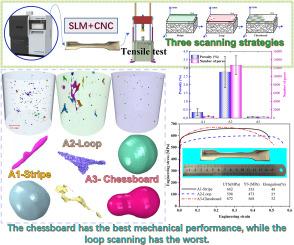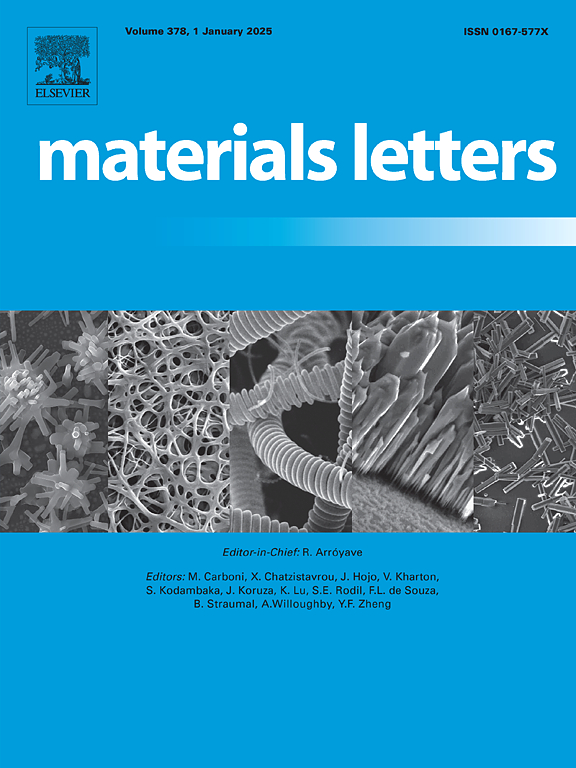扫描策略对添加剂制造的 316L 不锈钢部件的缺陷分布和机械性能的影响
IF 2.7
4区 材料科学
Q3 MATERIALS SCIENCE, MULTIDISCIPLINARY
引用次数: 0
摘要
研究了扫描策略对添加剂制造(AM)316L 不锈钢部件的缺陷分布和机械性能的影响。采用三种扫描策略(A1-条纹、A2-环形、A3-棋盘),使用 X 射线显微镜(XRM)研究缺陷特征,并通过拉伸试验评估由此产生的机械性能。结果表明,棋盘式策略产生的缺陷更少、更小、更均匀,因此抗拉强度更高,各向异性更小。相比之下,环形策略会在表面附近产生更高密度的细长缺陷,导致应力集中增加,拉伸性能降低。这项研究为优化扫描策略以加强缺陷控制,从而改善增材制造中 316L 不锈钢的整体机械性能提供了启示。这些发现有助于推进工艺设计,以减少增材制造部件中的缺陷和结构完整性。本文章由计算机程序翻译,如有差异,请以英文原文为准。

The effect of scanning strategies on the defect distribution and mechanical properties of additive manufactured 316L stainless steel components
The effect of scanning strategies on defect distribution and mechanical properties of additive-manufactured (AM) 316L stainless steel components was investigated. Three scanning strategies (A1-stripe, A2-loop, A3-chessboard) were applied to study the defect characteristics using X-ray microscopy (XRM) and evaluate the resulting mechanical behavior through tensile tests. The results indicate that the chessboard strategy produces fewer, smaller, and more uniform defects, contributing to superior tensile strength and reduced anisotropy. In contrast, the loop strategy results in a higher density of elongated defects near the surface, leading to increased stress concentrations and lower tensile performance. This study provides insights into optimizing scanning strategies to enhance defect control, thereby improving the overall mechanical properties of 316L stainless steel in additive manufacturing. These findings are instrumental in advancing the process design for defect mitigation and structural integrity in AM components.
求助全文
通过发布文献求助,成功后即可免费获取论文全文。
去求助
来源期刊

Materials Letters
工程技术-材料科学:综合
CiteScore
5.60
自引率
3.30%
发文量
1948
审稿时长
50 days
期刊介绍:
Materials Letters has an open access mirror journal Materials Letters: X, sharing the same aims and scope, editorial team, submission system and rigorous peer review.
Materials Letters is dedicated to publishing novel, cutting edge reports of broad interest to the materials community. The journal provides a forum for materials scientists and engineers, physicists, and chemists to rapidly communicate on the most important topics in the field of materials.
Contributions include, but are not limited to, a variety of topics such as:
• Materials - Metals and alloys, amorphous solids, ceramics, composites, polymers, semiconductors
• Applications - Structural, opto-electronic, magnetic, medical, MEMS, sensors, smart
• Characterization - Analytical, microscopy, scanning probes, nanoscopic, optical, electrical, magnetic, acoustic, spectroscopic, diffraction
• Novel Materials - Micro and nanostructures (nanowires, nanotubes, nanoparticles), nanocomposites, thin films, superlattices, quantum dots.
• Processing - Crystal growth, thin film processing, sol-gel processing, mechanical processing, assembly, nanocrystalline processing.
• Properties - Mechanical, magnetic, optical, electrical, ferroelectric, thermal, interfacial, transport, thermodynamic
• Synthesis - Quenching, solid state, solidification, solution synthesis, vapor deposition, high pressure, explosive
 求助内容:
求助内容: 应助结果提醒方式:
应助结果提醒方式:


